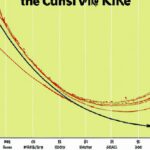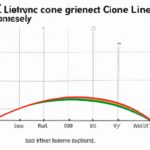The Lorenz curve helps study income inequality by showing how wealth is distributed among households. Economists use it to analyze disparities in income distribution and measure the effectiveness of economic policies aimed at reducing inequality. By comparing the Lorenz curves of different countries, policymakers can assess the impact of various social and economic programs. This curve provides a visual representation of income inequality, with the diagonal line representing perfect equality. The further the Lorenz curve deviates from this line, the greater the income inequality in a society. Understanding and interpreting the Lorenz curve can guide policymakers in designing more equitable and effective economic policies.
Table of Contents
- Definition of Lorenz curve
- Empirical applications of Lorenz curve in analyzing income distribution
- Gini coefficient
- Measurement of income inequality using Lorenz curve
- Policy implications of income inequality analysis using Lorenz curve
(Lorenz Curve and Gini Coefficient – Measures of Income Inequality)
The Lorenz curve is a graph used in economics to illustrate income distribution among a population. It shows the cumulative proportion of total income received by the cumulative percentage of the population, from the poorest to the richest.
This curve is crucial in measuring income inequality within a society. Policymakers use it to assess the fairness of income distribution and to design effective social policies. By comparing the Lorenz curves of different countries or regions, economists can analyze and compare income disparities.
Furthermore, the Gini coefficient, derived from the Lorenz curve, quantifies income inequality numerically, providing a clearer understanding of the distribution of wealth. Governments use this measure to evaluate the impact of their policies on income distribution and social welfare.
In addition to its application in economics, the Lorenz curve has also found uses in various other fields, such as healthcare and environmental studies. It is a versatile tool that helps researchers analyze the distribution of resources and identify areas requiring attention and intervention.
Overall, the Lorenz curve is a powerful visual representation that plays a significant role in shaping economic policies and social programs, aiming to create a more equitable and just society for all its members.
Definition of Lorenz curve
The Lorenz curve is like a powerful storyteller in the field of economics. It’s not just some fancy graph; it actually paints a vivid picture of income inequality within a society. Imagine this curve as an artist’s brush strokes on canvas, revealing how wealth is distributed among individuals or households.
To put it simply, the Lorenz curve shows us who gets what slice of the economic pie. Picture a scenario where 20% of people hold 80% of the total income – this would be reflected by a steeply curved line towards one corner of the graph. On the other hand, if everyone had equal income, you’d see a straight diagonal line from bottom left to top right.
Now, here’s where things get interesting – economists use this curve to calculate something called the Gini coefficient. This number gives us a concrete measure of inequality within a population. The closer it is to zero, the more evenly wealth is spread across society; conversely, nearing one indicates high levels of inequality.
Let me give you an emotional analogy for better understanding: imagine being at a dinner table with ten friends and only two people devouring most dishes while others stare hungrily at their empty plates. That visual disparity mirrors what the Lorenz curve exposes about unequal distribution.
This tool isn’t just theoretical mumbo-jumbo either – policymakers utilize it extensively to shape social welfare programs and tax policies that aim to level out financial disparities amongst citizens. By studying these curves closely, they can devise strategies that help bridge gaps between privilege and poverty.
So next time you come across those curvy lines in an economic report or article discussing income distribution issues—remember that behind those arcs lies real human stories: struggles for equality and debates on fairness echoing through our societal structures like ripples on water surface disturbed by pebble drops.
Empirical applications of Lorenz curve in analyzing income distribution
Income distribution is a hot topic in economics, and one powerful tool used to analyze it is the Lorenz curve. You might ask, what exactly can this curve tell us about how income is spread among different groups of people? Well, let me break it down for you in simple terms.
Imagine a line graph that showcases how much of the total income is earned by various percentiles of the population. The Lorenz curve starts at the bottom left corner representing the lowest earners and moves upwards to the right, with each point showing a higher percentile of society.
By looking at this curve, economists can gain insights into income inequality within a country or region. Are there just a few individuals holding most of the wealth while others struggle to get by? Or perhaps income is more evenly distributed across all sectors of society?
One common empirical application of the Lorenz curve involves calculating the Gini coefficient. This numerical value derived from analyzing the area between the perfect equality line (where everyone earns an equal share) and the actual Lorenz curve gives us a precise measure of income inequality.
For instance, if we observe that a country’s Lorenz curve bows further away from perfect equality compared to another nation’s curve, we can deduce that income concentration is higher in that first country – meaning some are making significantly more money than others.
These calculations come alive when applied to real-world scenarios. Picture yourself examining two countries: Country A has a steeply sloped Lorenz curve indicating high inequality; while Country B’s curve shows less deviation from equality signifying fairer distribution.
As you delve deeper into these representations through empirical data analysis using statistical software like R or Python, emotions may run high as you uncover stark disparities within communities. Your heart may ache when realizing how some families struggle day-to-day due to unequal access to resources and opportunities reflected in these curves.
In conclusion, while mathematical tools like Lorenz curves may seem abstract on paper initially, their real impact lies in shedding light on societal issues surrounding economic fairness and social justice – stirring feelings of empathy and driving actions towards creating more equitable systems for all members of our global community.
Gini coefficient
The Gini coefficient is a crucial tool in economics, closely tied to the Lorenz curve. Picture this: You’re standing on a hill overlooking a bustling city, watching as wealth flows through its streets like an intricate dance. The Gini coefficient helps us measure how evenly or unevenly that wealth is distributed among the city’s residents.
Imagine lining up every person in the city based on their income, from the lowest earner to the highest roller. The Gini coefficient looks at this line-up and calculates if there’s a fair distribution of wealth or if it heavily tilts towards just a few big earners.
It ranges from 0 (perfect equality where everyone has an equal share) to 1 (perfect inequality where one person owns everything). An area bounded by perfect equality and your observed Lorenz curve represents total inequality; hence, higher Gini coefficients signal more significant income disparities within society.
This metric isn’t just about numbers—it reflects real people’s lives. Think about families struggling to make ends meet while others live luxuriously without any financial worries. When you see a high Gini coefficient for a region, it paints a stark picture of social disparity and economic hardship faced by many individuals and families.
In practical terms, governments use the Gini coefficient data to shape policies aimed at creating more balanced societies. It serves as an eye-opener—a reality check that reminds policymakers of who truly benefits from economic growth and who gets left behind.
For economists and researchers alike, analyzing trends in Gini coefficients over time unveils critical insights into societal changes—whether inequalities are narrowing or widening with each passing year. These fluctuations can shape not only economic forecasts but also influence political landscapes and public sentiments deeply intertwined with issues of fairness and justice.
So next time you come across discussions about income distribution or poverty rates in different regions around the world, remember that little number—the Gini coefficient—that holds immense power in revealing stories of haves and have-nots within our societies.
(Gini Coefficient and Lorenz Curve)
Measurement of income inequality using Lorenz curve
In economics, the measurement of income inequality plays a crucial role in understanding societal disparities. The Lorenz curve is a powerful tool that provides insights into wealth distribution within a population. Imagine standing at the edge of a vast field where each point represents an individual’s income level. As you plot these points on a graph and connect them with lines, the Lorenz curve begins to take shape.
The curvature of this line reveals how equally or unequally income is distributed among people. A perfectly equal society would show a straight diagonal line, signifying that everyone earns precisely the same amount. However, reality paints a different picture. In most cases, the Lorenz curve bows away from this diagonal ideal, showcasing varying degrees of income inequality.
By quantifying this bend through mathematical calculations, economists derive what is known as the Gini coefficient—a numerical representation of income disparity ranging from 0 (perfect equality) to 1 (maximum inequality). This metric serves as a compass guiding policymakers towards designing targeted interventions to address social imbalances effectively.
Visualize two scenarios: one where the Lorenz curve bends gently, indicating relatively fair wealth distribution among citizens; and another where it arches sharply downwards, highlighting extreme concentration of riches in few hands. Emotions may run high when confronted with such stark contrasts—anger at systemic injustices fueling poverty or hope for initiatives aimed at leveling the playing field.
As researchers delve deeper into dissecting these curves, stories emerge from data points—an elderly couple struggling to make ends meet despite decades of hard work; a young entrepreneur breaking barriers to climb up the economic ladder against all odds; families torn apart by financial burdens they cannot bear alone.
Witnessing these narratives unfold through statistical analysis breathes life into abstract concepts like Gini coefficients and Lorenz curves. They cease being mere graphs on paper but become windows offering glimpses into real lives shaped by economic dynamics beyond their control.
So next time you gaze at a Lorenz curve snaking its way across an axis, remember it tells more than numbers—it speaks volumes about societal structures influencing our collective destinies and ignites conversations on reshaping tomorrow for greater equity and justice.
Policy implications of income inequality analysis using Lorenz curve
Analyzing income inequality through the lens of the Lorenz curve unveils a mosaic of societal disparities that policymakers must navigate. The graceful arc of the Lorenz curve illustrates how wealth is distributed among a population, shedding light on who benefits most and least from economic growth.
As policymakers delve into these insights, they encounter a landscape rich with implications. One key takeaway is the need for targeted interventions to bridge the gap between the haves and have-nots. By pinpointing regions or demographic groups lagging behind in income distribution, authorities can tailor policies such as progressive taxation or social welfare programs to uplift those marginalized by inequity.
The poignant bend in the Lorenz curve reveals not just numbers but human stories—families struggling to make ends meet, individuals thwarted by limited opportunities. This emotional resonance underscores why addressing income inequality isn’t just an economic imperative but a moral one too. When segments of society are left behind while others flourish, societal cohesion frays, sowing seeds of discontent and unrest.
Moreover, as policymakers absorb the nuances mapped out by the Lorenz curve analysis, they realize that sustainable economic prosperity hinges on inclusive growth. A society cannot thrive if its wealth accumulates disproportionately in a few hands while vast swathes languish in poverty. The lopsided shape traced by the Lorenz curve serves as a stark reminder that true progress lies not just in GDP figures but in ensuring equitable access to resources and opportunities for all.
Navigating these policy waters requires deft navigation—the delicate balance between incentivizing innovation and safeguarding social welfare; fostering entrepreneurship without widening income chasms further; promoting meritocracy while leveling playing fields skewed by historical injustices.
In conclusion, delving into income inequality through the prism of the Lorenz curve elevates policymaking from abstract theories to tangible realities lived by people every day. It beckons lawmakers to craft measures that aren’t merely statistics on paper but lifelines for those trapped in cycles of poverty and marginalization—a call to action resonating with both analytical rigor and heartfelt empathy.












